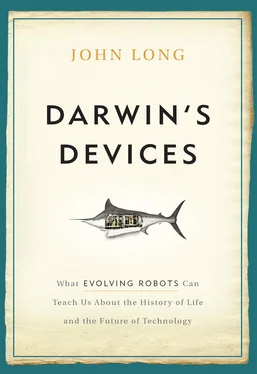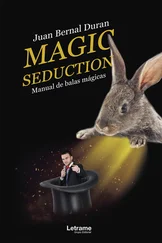In the end, with all of this wonderful confusion surrounding the identity of the mother of all vertebrates, the specific vertebrate we chose as our target for designing Evolvabots was the tadpole larva of living tunicates. What finally sold us was that Matt McHenry, working at the time as a PhD student in the laboratory of Professor Mimi Koehl, University of California, Berkeley, had figured out the neural circuitry involved in the swimming behavior of tunicate larvae.
Using careful experiments in which he altered the direction that light hit swimming larvae in a tank, McHenry showed that the tadpole larvae were using a very simple mechanism to orient toward and then away from the light, in a behavior known as positive and negative phototaxis, respectively (see Figure 3.2). The mechanism is called helical klinotaxis (HK) and refers to the fact that many small swimming animals move in helical pathways, as if along the threads of a screw, as they move toward or away from something in their environment, like light or the chemical plume of a food source. Although spiraling along in a helix may seem inefficient (why not just swim in a straight line?), Hugh Crenshaw, working before McHenry in the laboratory of Steven Vogel at Duke University, had shown that it was actually efficient in terms of control. To control your directions in three dimensions, all you, as a small swimmer, need to do is change two variables: your translational (straight) and rotational velocity.
When I saw McHenry present his work on tunicate tadpole larvae at a scientific meeting, I remember nearly shouting out, “Let’s build a tadpole robot!” His mathematical model, which he had worked on with Jim Strother, gave us what we needed to know about the likely neural control of HK in a chordate. Fortunately for us, McHenry and Strother agreed to help transfer their knowledge of HK and tadpole larvae into a robotic form.
DESIGN QUESTION 2: WHICH FEATURES OF THE ANIMAL WILL THE EVOLVABOTS POSSESS AND WHY?
“Keep it simple, stupid.” This quote, allegedly from pioneering aerospace engineer Kelly Johnson, is known throughout the design community as the KISS principle. The KISS principle is important at this stage in the design because in the heat of jubilant complexification, it helps keep your feet on the ground and your eyes on the target. KISS forces you to rephrase design question 2: what is the least we can do to fulfill our overall design goal?
For scientists, doing the simplest thing first has a very important philosophical basis: adding complexity to your model requires a combinatorial explosion of decisions, and each decision has an impact on the outcome of your design. And even more importantly, connecting back from your results to the causal elements in your design requires that you understand every element in your design and how every element interacts with all of the other elements. The simpler your design—the more KISS inspired that it is—the better your chances of understanding what the heck you’ve created. This KISS-first approach is one of the guiding principles at Vassar College when we work with students in the Interdisciplinary Robotics Research Laboratory. Undergraduates Adam Lammert and Joseph Schumacher, both cognitive science majors at Vassar, applied the KISS principle when they built the robots that we talk about in this chapter.
Embracing the KISS principle, we decided to keep our wish list of features short: (1) behavior: helical klinotaxis; (2) sensor: single eyespot; (3) brain: simple processor that turns the light intensity signal from the eyespot into a turning command for the motor; (4) motor: one, used for both driving and turning the tail; (5) body: a simple round bowl; (6) tail: a notochord with a flared caudal fin. Although this list may seem like a long one, keep in mind that some features are as simple as you can get (e.g., single eyespot, bowl for a body) and some features are simply missing (e.g., muscles, other sensors, a mouth).
The design of the first Tadro started in 2003 with Adam, a Vassar undergraduate and cognitive science major. He was interested in robotics, and we talked about taking McHenry and Strother’s neuromuscular model for tunicate tadpole larvae and making a simple robot, relying on an insight from Chuck Pell.
Chuck had been working on three-dimensional helical klinotaxis with Hugh, of Duke University. Hugh, a biomechanist trained for his PhD by Steven Vogel, had made a true breakthrough by figuring out how to measure and mathematically describe the 3-D motion of the single-celled organisms that swim almost exclusively using HK. Later Hugh, as a faculty member at Duke, and Chuck, working with Professor Steve Wainwright out of Duke’s BioDesign Studio, created the first autonomous robot that used an HK algorithm, a small torpedo-shaped vessel. Capable of navigation with a only a single propeller for control and orientation, the robot would become known as Microhunter. For our purposes, Chuck’s insight was that the three-dimensional HK used by the tunicate tadpoles would also work in two dimensions. This meant that we could stay on the surface of the water, avoiding the engineering complexities of moving in three dimensions while keeping our electronics dry. KISS in action.
For all of this work, Tadro1 was not yet an Evolvabot. [19] You can read about Tadro1 in J. H. Long Jr., C. Lammert, C. A. Pell, M. Kemp, J. Strother, H. C. Crenshaw, and M. J. McHenry, “A Navigational Primitive: Biorobotic Implementation of Cycloptic Helical Klinotaxis in Planar Motion,” IEEE Journal of Oceanic Engineering 29, no. 3 (2004): 795–806.
The transformation from biorobot to Evolvabot was driven by the interests of another cognitive science major at Vassar, Joe Schumacher, who helped endow Tadro1 with a backbone so that we could begin studying backbone biomechanics using robots.
Rob Root, Chun Wai Liew, Tom Koob, and I had tried to fund our research on the biomechanics of backbones straight-up, with no robots. We had seen two of our proposals to the National Science Foundation (NSF) rejected. The third time was a charm, and the change that made the difference—adding robots—came about almost by accident. In the fall of 2003 I worked on a review panel at NSF down in Arlington, Virginia—it was the same panel that had twice rejected our grant. The real power in the room was the program officer, who had the final say about which projects were funded. When a chorus of positivity would arise from the panelists, she’d put down her pen and start asking tough questions. When a break came in the day’s work, I got a chance to ask her a question. Having previously reminded her of my two failed proposals, I went over and, without any preamble, blurted, “What about robots?” She looked up, paused without giving me eye contact, then, looking at me directly, said, “Robots would be good.” That was all I needed to know.
Back at Vassar, Joe and I started scheming. Tadro1 didn’t have a biomimetic notochord yet, but Adam, Tadro1’s departing creator, helped Joe create Tadro2 by giving Tadro1 two important upgrades: (1) a computerized brain (replacing Tadro1’s analog circuitry) and (2) a genetic algorithm that coded for the size of a flapping tail made out of duct tape. Joined in the summer of 2004 by Nick Livingston, Joe quickly created a water world, programmed the digital brain, and set out to design a biomimetic notochord and vertebral column. For the electronics and the new Tadro body, he enlisted help from John Vanderlee and Carl Bertsche, Vassar’s electronics technician and machinist.
By the time our NSF funding started in January of 2005, Joe was already replacing Tadro2’s duct-tape tail with one that had a simple rod serving as a notochord. He used ten-centimeter-long cylindrical erasers as the notochord, plastic clamps as vertebrae, and then put a flared caudal fin on the end. Together we designed the genetic algorithm that would code for the evolvable traits: the length of the axial skeleton and the number of vertebrae. Nick made an important innovation: he wrote a program that allowed Tadro2 to make its tail adjustments for maneuvering using the same motor that flapped the tail. This architecture further reduced the complexity of Tadro2 and made it much more reliable. With our incoming students, whom we called “Fish Fellows,” we quickly realized that notochords made of erasers weren’t making sense because we couldn’t change the stiffness of the erasers’ material. The solution—building the notochord out of a biomaterial whose stiffness we could vary—would come from Tom Koob, as we’ll see on the next pages. With the change to the brain and the tail of Tadro2, we realized that we really had a new critter: Tadro3 (Figure 3.3).
Читать дальше












